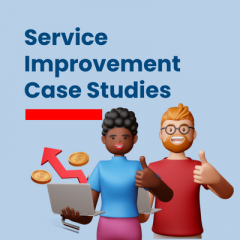by Ivor Macfarlane

End users, business colleagues, consumers, customers, or whatever else you wish to call them are increasingly demanding more from the IT services and support they receive from the corporate IT department. Their personal-life, consumer-world, experiences are upping their expectations of services, support, and customer services; with these expectations continually raised by the growing business-to-consumer (B2C) investments in capabilities that provide a better customer experience. It’s ultimately an effective B2C strategy to win and retain customers.
This investment can affect many areas of IT service delivery and support. But one where it has hurt, and continues to hurt, the success of IT department cost-saving and/or service-improving initiatives most is self-service.
Getting IT self-service right is hard
The industry statistics show this. You might have already felt it – because the time and money (and perhaps blood, sweat, and tears) you’ve invested in your IT self-service capability has failed to achieve the employee-usage levels you wanted. And, because of this low level of usage, the self-service capability hasn’t delivered the promised benefits – benefits that include a better customer experience. After all, without users or customers there can be no customer experience.
So, how do you get self-service right?
This is something that I’ll be covering, in addition to how other technology use cases can deliver a better customer experience, in an upcoming SDI and ITSM.tools webinar entitled: “5 Ways Technology is Changing IT Support Forever”.
Here’s a taster of what I’ll cover regarding achieving self-service success:
1. Treat self-service as a business project – recognizing that self-service isn’t about the implementation of new technology. That it’s instead a business project that changes the way in which employees work, in the pursuit of better business outcomes. So, involve the real end users from the get-go; and make those involved a reflection of the whole organisation across different role types, different departments, different locations, different levels of seniority, and different levels of IT proficiency. Try to cover all the bases in terms of how employees want and need to work, and what terms such as “intuitiveness” and “ease of use” really mean to them.
2. Focus on a better customer experience over cost savings – while it’s not unsurprising that self-service is viewed as a great way in which to reduce costs, these savings and a positive return on investment (ROI), will only be realised if there’s sufficient employee usage. Ultimately, an overly-complex, or “cheap and cheerful”, capability will not drive sufficient self-service usage to generate the anticipated savings. Whereas, the better the customer experience and outcomes, the more self-service will get used and the more the service desk can hope to save. So, make financial savings a secondary objective, realising that there needs to be a sufficient volume of self-service use to generate any meaningful benefits.
3. Use organisational change management techniques to facilitate the transition – understanding that the people-side of self-service is more about changing behaviours and the way of working than it is training employees to use a new technology. Recognising that employees not only need to know the “how” of self-service, but that they also need to know the “why.” Thus, an investment in a proven organisational change management (OCM) methodology is required to help understanding and to minimise the resistance to change that manifests from people’s dislike of the unknown. The bottom line is that employees need to understand why self-service is better for them and the business, and for self-service to be an easier and better experience than the existing, alternative IT support access and communication channels.
There’s so much more that needs to be said about how to get self-service right too. Plus, in terms of the technologies we also need to cover knowledge management, chat, machine learning, and chatbots too. So, I’ll also be talking about these in the webinar.
Why? Because too many organisations make the same, or very similar, mistakes with knowledge management as they do with self-service. And who’s to say that this over-focusing on the technology isn’t also going to be repeated with the growing use of chat and the introduction of machine learning and chatbots?
Want some more free advice?
If so, then please join me, SDI, ITSM.tools and Zendesk on 13 July 2017 2pm BST for “5 Ways Technology is Changing IT Support Forever”. This webinar will talk to how:
● The benefits of self-service and how to reap them
● Chat’s consumer-world popularity and success needs to be replicated internally
● Knowledge management, if done right, will play a key role in both self-service success and service-desk improvement
● Machine learning will transform IT support capabilities
● The use of chatbots can benefit both employees and IT staff.
Please click here to register and we look forward to presenting to you.























